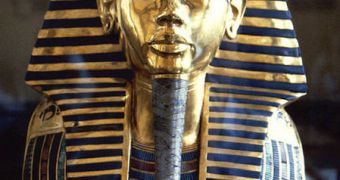Inscriptions on a fragment of an ancient limestone block bring new evidence in the long controversy related to the lineage of King Tutankhamun. As it appears, when the fragment was joined with the rest of the block, the full inscription suggested that Tutankhamun's father was Akhenaten, his predecessor to Egypt's throne. The missing fragment, which was found several months ago in a storeroom in the city of el Ashmunein, on the western bank of the Nile, about 150 miles (240 km) south of the capital Cairo, also pointed that Tut had married his half sister, Ankhesenamun.
"We can now say that Tutankhamun was the child of Akhenaten," explained Zahi Hawass, chief of Egypt's Supreme Council of Antiquities, for Discovery, adding that the complete stone block was "an accurate piece of evidence that proves Tut lived in el Amarna with Akhenaten and he married his wife, Ankhesenamun. The block shows the young Tutankhamun and his wife, Ankhesenamun, seated together. The text identifies Tutankhamun as the 'king's son of his body, Tutankhaten,' and his wife as the 'king's daughter of his body, Ankhesenaten,'" stated Hawass.
"We know that the only king to whom the text could refer as the father of both children is Akhenaten, himself. We know from other sources that Ankhesenamun was the daughter of Akhenaten and Nefertiti. Now, because of this block, we can say that Tutankhamun was the child of Akhenaten as well," he concluded.
This is new evidence for the prevalent theory among historians and archaeologists, to the detriment of others which portray either minor king Smenkhkare or Akhenaten's father, Amenhotep III, as the young pharaoh's father. It still remains uncertain, though, who Tut's mother was. Lead hypothesis point to Akhenaten's wives Kiya (although she would have been 50 when Tut was born) or Nefertiti.
Tutankhamun (meaning "living image of Amun" or "honoring Amun") inherited the throne at the age of nine from his predecessor, the "heretic" Akhenaten, who reigned between 1353-1336 BC. The most famous of the Egyptian rulers, Tut reinstalled the polytheistic religion over Akhenaten's attempt of a monotheistic one. His tomb and mummy, found in 1922 by Howard Carter, were the most complete ones ever found.
His death at the age of 19 (possibly caused by leg gangrene caused by a wound, as latest studies suggested) brought the end of the great pharaoh dynasties (his was the 18th) and opened the doors to military rule, such as the one of his former vizier, Ay, who is thought to have made most of the important decisions attributed to the young ruler, and also to have caused the wound that eventually led to his death.

 14 DAY TRIAL //
14 DAY TRIAL //